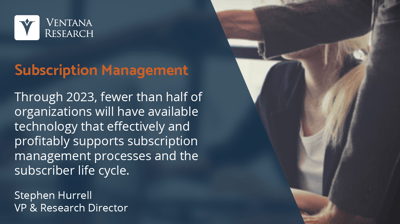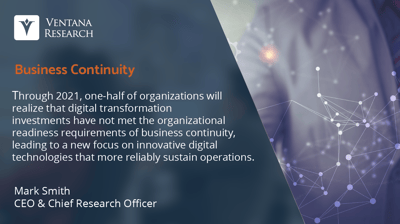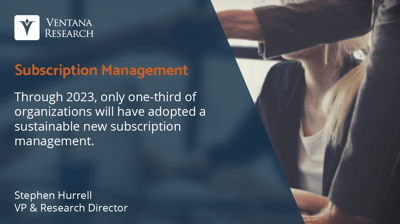Subscription-based business models have seen exponential growth over the last decade. The growth of this recurring revenue business model, where a subscriber commits to repeatedly pay for a good or device for a fixed or indefinite timeline, has been caused by the shift from the one-time selling of physical products to selling digital services on a subscription basis. The first phase of this transformation was led by “digitally native” organizations, typically B2C, that have only ever offered services via subscription. Although a large market in its own right, it is still dwarfed by businesses selling physical products. But this market is also changing, as more and more traditional organizations transition some or all of their revenue to the subscription economy. Ventana Research asserts that through 2023, fewer than half of organizations will have the correct technology in place to support such a transition. This Analyst Perspective looks at some of the key implications of this transition and what it means for technology choices as companies move toward a subscription management approach to overseeing the subscribers and usage of their products and services.
economy. Ventana Research asserts that through 2023, fewer than half of organizations will have the correct technology in place to support such a transition. This Analyst Perspective looks at some of the key implications of this transition and what it means for technology choices as companies move toward a subscription management approach to overseeing the subscribers and usage of their products and services.
The need for organizations to adapt their business models is being driven by a variety of factors. As an example, consider technology resellers, who have historically focused on selling the physical products of their suppliers. Now their suppliers are transitioning away from physical products to digital, cloud-based platforms. In addition, resellers can also sell new, alternative approaches such as cloud services from the likes of AWS, Google, IBM and Microsoft.
In contrast to familiar and straightforward fixed pricing B2C subscription models such as Netflix, contracts or orders under an average B2B model are custom negotiated with an eye for competitive pricing. In addition, unlike B2C flat fee subscription pricing, B2B is often based on usage, where the price or rate is not known until the periodic usage is evaluated. This pricing strategy is typically formula-based, with the price computed on actual usage. These pricing formulas can be complex, e.g. using data aggregated within tiers, aggregated over time or multiple attributes based on where consumed and when.
Customer expectations, including B2B or B2B2C, are being shaped by the personal experiences seen in day-to-day engagements. The distinction between the experience expected as an individual consumer and as a business buyer are blurring. Customers are demanding more flexibility from organizations as their needs change. Failing to adapt quickly to new customer demands and market conditions can result in losing major market share. Often, the sole points of contact between a customer and the vendor after the initial sale are billing, payments and order changes. To preserve long-term customer relationships, these interactions need to be frictionless and easy. Any errors, difficulties or disjointedness are asking for the customer to leave at the time for renewal.
While there are similarities on the surface between B2B and B2C, and the expectation of the customer—or what we call the “subscriber experience”—is the same, there are also substantial differences that need to be acknowledged and planned for with the appropriate technology and approach. My colleague, Mark Smith, Ventana Research’s chief research officer, outlined  the necessity of subscriber experience in his perspective supporting the business continuity imperative. As he asserts, through 2021, one-half of organizations will realize that digital transformation investments have not met the organizational readiness requirements of business continuity, leading to a new focus on innovative digital technologies that more reliably sustain operations.
the necessity of subscriber experience in his perspective supporting the business continuity imperative. As he asserts, through 2021, one-half of organizations will realize that digital transformation investments have not met the organizational readiness requirements of business continuity, leading to a new focus on innovative digital technologies that more reliably sustain operations.
One of the major challenges faced by B2B customers using either traditional or modern, subscription-based models is how to govern who owns the billing process. For many organizations, orders are handled by a CRM system, while invoicing and bill presentment are handled out of their ERP system. Both ERP and CRM vendors are now rapidly improving their ability to support subscription billing.
Whether totally subscription and usage, or a mixture of the traditional and the new, building an agile subscription-based business in this volatile economy requires continuous digital innovation. This includes managing and improving complex pricing structures, personalized user experience, accurate revenue recognition, nurturing customer relationships and developing scalable technology infrastructure. For organizations where product and product bundles increasingly include third-party products and services, there is an additional need to generate accurate partner payments, often on different cycles than billing, and often driven by complex computations requiring aggregation over time and over reporting structures. Trying to manage all this on spreadsheets, along with a lack of synchronization between dedicated software for pricing, billing, collection and accounting is time-consuming, prone to potentially costly mistakes and difficult to scale.
One of the most challenging aspects for organizations with mixed business models is how to ensure that you do not end up with two billing systems that are either not integrated or use batch-oriented and periodic updates. As in the above technology reseller example, the customers are ordering from a mix of one-time product sales and recurring services. The customer does not want to receive two invoices or have two points of contact. Any technology approach needs to ensure that the organization is not creating a parallel system, but one that generates relevant billing and payment information, and utilizes the existing accounts receivable and accounts payable processes that already exist with the customer.
The solution to most of these challenges is automation. Interconnected systems and processes that adapt to new changes automatically and dynamically can save hundreds of work hours, allowing your organization to focus on scaling its subscription. In addition, the subscriber’s journey needs to be seamless. Any changes should be captured and instantaneously  transferred throughout the subscription ecosystem so that the customer is “hidden” from the process. A quality subscriber experience requires the right technology, which we currently don’t find in traditional ERP or CRM applications, or even in digital commerce approaches. We assert that through 2023, only one-third of organizations will have adopted a sustainable, new subscription management strategy.
transferred throughout the subscription ecosystem so that the customer is “hidden” from the process. A quality subscriber experience requires the right technology, which we currently don’t find in traditional ERP or CRM applications, or even in digital commerce approaches. We assert that through 2023, only one-third of organizations will have adopted a sustainable, new subscription management strategy.
Organizations looking to transition their existing legacy business in whole or in part to a subscription-based model must carefully consider the customer’s subscriber experience. New technology that can sit alongside, integrate and provide relevant billing information to existing systems will be needed to avoid generating two invoices, one for legacy products and one for subscription-based services. Organizations must also examine the synchronization of product, customer and pricing list management to ensure that any changes to a customer’s order can be seamlessly integrated. It is vital that organizations understand their own competitive landscape. This knowledge will determine whether their pricing model needs to support usage-based or flat fee subscription services, and whether the pricing and rating engine is sufficiently flexible to support the necessary rules and formulas that will preserve an organization’s competitive advantage.
Regards
Stephen Hurrell


 economy. Ventana Research asserts that through 2023, fewer than half of organizations will have the correct technology in place to support such a transition. This Analyst Perspective looks at some of the key implications of this transition and what it means for technology choices as companies move toward a subscription management approach to overseeing the subscribers and usage of their products and services.
economy. Ventana Research asserts that through 2023, fewer than half of organizations will have the correct technology in place to support such a transition. This Analyst Perspective looks at some of the key implications of this transition and what it means for technology choices as companies move toward a subscription management approach to overseeing the subscribers and usage of their products and services. the necessity of subscriber experience in his perspective supporting
the necessity of subscriber experience in his perspective supporting  transferred throughout the subscription ecosystem so that the customer is “hidden” from the process. A quality subscriber experience requires the right technology, which we currently don’t find in traditional ERP or CRM applications, or even in digital commerce approaches. We assert that through 2023, only one-third of organizations will have adopted a sustainable, new subscription management strategy.
transferred throughout the subscription ecosystem so that the customer is “hidden” from the process. A quality subscriber experience requires the right technology, which we currently don’t find in traditional ERP or CRM applications, or even in digital commerce approaches. We assert that through 2023, only one-third of organizations will have adopted a sustainable, new subscription management strategy.








